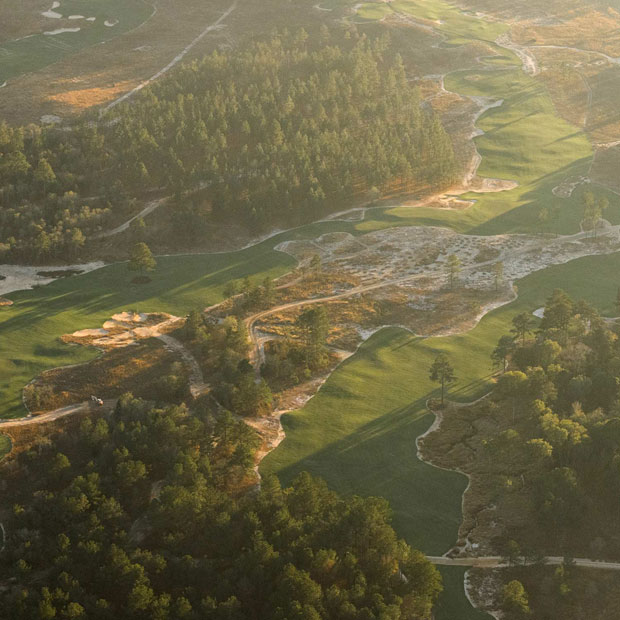Can Royal Troon Be Emulated?
It's tempting to try and import features that make links golf so special, but the reality is more complicated


When you watch a tournament like the 2024 Open Championship—a tournament where players have to make allowances for trajectory and accuracy on every shot, where a 123-yard par 3 is the scariest hole on the course, where experience and savvy trump youth and power—it’s natural to ask, “Why isn’t professional golf like this more often?” And it’s equally natural to brainstorm ways that regular tour venues could be changed to resemble Royal Troon. How about more pot bunkers? Bottlenecks between 300 and 350 yards from the tee? Thicker rough?
If those design and setup choices work at the Open, it stands to reason that they could be emulated anywhere.
That’s more or less the conclusion architect Pete Dye came to after visiting Scotland to study links golf 60 years ago. Dye went on to use deep, steep-sided bunkers, varied fairway widths, and smallish, domed greens at courses like Harbour Town and TPC Sawgrass. These designs reinvigorated American golf architecture, creating a bridge between the modernist era of Robert Trent Jones and the neoclassical one of Coore & Crenshaw and Tom Doak. To this day, many of Dye’s courses pose a stern and nuanced challenge to elite players. They may not look much like Open venues, especially since most of them are maintained more like Augusta National than Royal Liverpool, but their links-influenced characteristics are still discernible.
So if current golf architects want to derive fresh inspiration from Royal Troon and other British championship courses, I won’t object. But I will raise a few complicating points:
1. The way artists absorb influences is always selective. When Pete Dye toured the links of Scotland, he focused on certain elements: abrupt pot bunkers, snaking fairways bordered by dunes and native grasses, and diminutive greens. He brought those ideas back across the Atlantic and translated them into an American idiom. But when Dye’s trainees Bill Coore and Tom Doak made similar trips to the foundational grounds of the game, they paid attention to different things. They saw and loved the enormous, undulating fairways and greens of the Old Course. They learned that many links courses had changed since their early days, and not necessarily for the better: playing corridors had shrunk, and naturally rugged sand scrapes had been formalized and stabilized by revetting. They discovered, in other words, that many of the aspects of links courses that Dye had admired and imitated were recent contrivances rather than original components. So, in some of their own work, Coore and Doak sought to capture an older, rawer version of British and Irish links golf. In so doing, they pushed golf architecture forward, just as Dye had before them.
The lesson here is that we shouldn’t try to determine ahead of time which traits of a course like Royal Troon will or should inspire a next-gen architect. Chaperoning artistic influence in this way is limiting, unimaginative, and probably fruitless.
2. Just because a course produces compelling events doesn’t mean it should serve as a model for every other tournament venue. Yes, Royal Troon has shown well in Opens since the 1920s, so it’s certainly not a bad reference point for championship design and setup. But we should remember that one of golf’s greatest strengths is its variety of playing fields. It’s okay—in fact, good—for some courses to have trees and others none, for some setup teams to prefer thick rough and immediate punishment while others emphasize width and options, for some venues to be bomber-friendly and others to give an advantage to accuracy over distance. There are many different ways for a course to present an exacting and interesting examination of playing ability. The game’s biggest tournaments should embrace that diversity, resist calls for standardization, and forge their own, unique paths to excellence.
Now, as a general principle, I believe that courses with wide fairways, firm turf, well-positioned hazards, varied topography and contour, and plenty of short grass around the greens tend to be more fun to play—and to watch be played—than courses defined by claustrophobia and irrigated rough. But this is not a universal truth. There’s room in the competitive game for Harbour Town as well as Augusta National, Carnoustie as well as the Old Course. Smart golf architecture has many faces.
3. Design and setup are just two parts of the mixture that made the 2024 Open great. The other elements were natural: wind and soil. From Thursday through Sunday, the coastal winds of South Ayrshire were strong and unpredictable, and the free-draining soils of Troon’s linksland allowed the playing surfaces to stay firm despite several rainy spells.
This combination of weather and agronomy forced players to deviate from their pre-tournament plans, play a variety of shot trajectories and shapes with precision, and muster levels of creativity and fortitude that weekly tour competition frankly doesn’t require. In the absence of 15-mile-per-hour gusts and bouncy greens, Royal Troon would have been far more vulnerable to the standard aerial attack preferred by today’s top golfers. Wind and soil were the spark plugs that ignited Troon’s design and setup last week.
The reality, then, is that imitating Royal Troon’s superficial features—fairways, bunkers, greens—on a site without linksy weather or turf would almost surely lead to disappointment.
So if we want the best golfers in the world to be challenged in the ways they were at Troon, the solution is both simple and admittedly tough to implement: the tours need to visit links courses more often. No other type of tournament venue can offer the same type of reliably unreliable weather, not to mention the capacity to remain playable through the worst of it.
But is it feasible for the PGA Tour, DP World Tour, and—why not—LIV Golf to create a longer “links season”? How would the scheduling work? And would such a concept have any shot of getting by the various financial officers and player-committee members whose opinions actually hold sway? My answers, for now: I don’t know, I’m not sure, and I sort of doubt it. Yet it also feels perfectly obvious, as we come down from the high of the 2024 Open, that links golf deserves a more prominent place in the professional game. Perhaps it’s the job of the tours, not writers or fans, to figure out how to make that happen.
This piece originally appeared in the Fried Egg Golf newsletter. Subscribe for free and receive golf news and insight every Monday, Wednesday, and Friday. For more coverage of the Open Championship, visit our Open hub.
Leave a comment or start a discussion
Engage in our content with thousands of other Fried Egg Golf Club Members
Engage in our content with thousands of other Fried Egg Golf Members
Get full access to exclusive benefits from Fried Egg Golf
- Member-only content
- Community discussions forums
- Member-only experiences and early access to events











Leave a comment or start a discussion
Lorem ipsum dolor sit amet, consectetur adipiscing elit. Suspendisse varius enim in eros elementum tristique. Duis cursus, mi quis viverra ornare, eros dolor interdum nulla, ut commodo diam libero vitae erat. Aenean faucibus nibh et justo cursus id rutrum lorem imperdiet. Nunc ut sem vitae risus tristique posuere. uis cursus, mi quis viverra ornare, eros dolor interdum nulla, ut commodo diam libero vitae erat. Aenean faucibus nibh et justo cursus id rutrum lorem imperdiet. Nunc ut sem vitae risus tristique posuere.